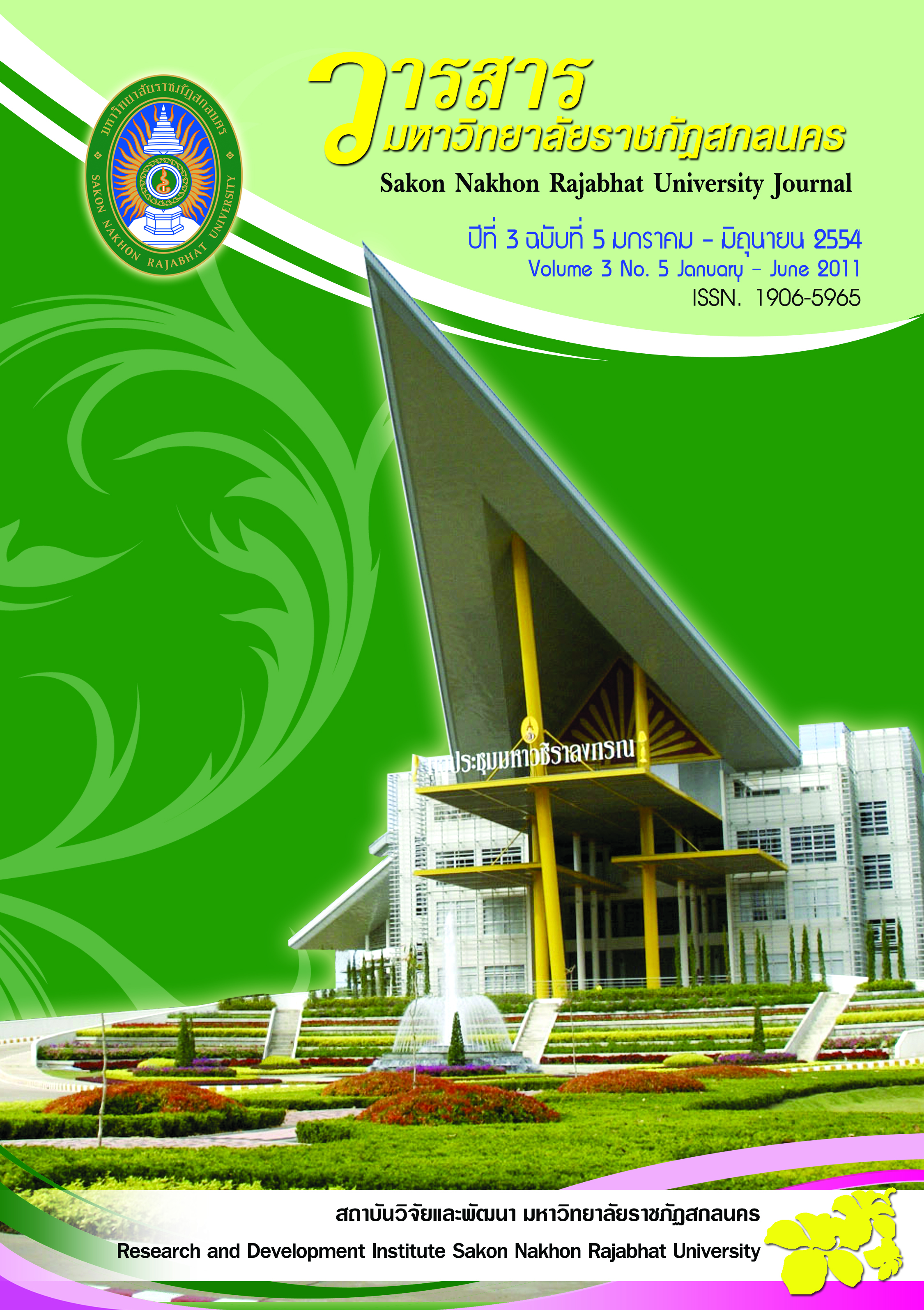สภาพและปัญหาการดำเนินการสร้างความสัมพันธ์ระหว่างโรงเรียนกับชุมชน ของโรงเรียนที่เปิดสอน ช่วงชั้นที่ 3 - 4 สังกัดสำนักงานเขตพื้นที่การศึกษา ในจังหวัดนครพนม
Abstract
บทคัดย่อ
การวิจัยครั้งนี้มีวัตถุประสงค์เพื่อศึกษาสภาพและปัญหาการดำเนินการสร้างความสัมพันธ์ระหว่าง โรงเรียนกับชุมชนของโรงเรียนที่เปิดสอน ช่วงชั้นที่ 3-4 สังกัดสำนักงานเขตพื้นที่การศึกษาในจังหวัดนครพนม กลุ่มตัวอย่างที่ใช้ในการวิจัยครั้งนี้จำนวน 586 คน ประกอบด้วยผู้บริหารโรงเรียน 45 คน ครูผู้สอน 315 คน และ คณะกรรมการสถานศึกษาขั้นพื้นฐาน 226 คน ใช้วิธีการสุ่มแบบหลายขั้นตอน เครื่องมือที่ใช้ในการเก็บ รวบรวมข้อมูลเป็นแบบสอบถามมาตราส่วนประมาณค่า มีค่าอำนาจจำแนกระหว่าง .41 – .87 และค่าความ เชื่อมั่นเท่ากับ .97 สถิติที่ใช้ในการวิเคราะห์ข้อมูลได้แก่ ร้อยละ ค่าเฉลี่ย ค่าเบี่ยงเบนมาตรฐานและการทดสอบ เอฟ ผลการวิจัยพบว่า 1) สภาพการดำเนินการสร้างความสัมพันธ์ระหว่างโรงเรียนกับชุมชนของโรงเรียนที่เปิด สอน ช่วงชั้น 3-4 โดยรวมอยู่ในระดับมาก 2) ปัญหาการดำเนินการสร้างความสัมพันธ์ระหว่างโรงเรียนกับ ชุมชน ของโรงเรียนที่เปิดสอนช่วงชั้น 3-4 โดยรวมอยู่ในระดับน้อย 3) สภาพการดำเนินการสร้างความสัมพันธ์ ระหว่างโรงเรียนกับชุมชนของโรงเรียนที่เปิดสอนช่วงชั้น 3-4 ตามความคิดเห็นของผู้บริหารโรงเรียน ครูผู้สอน และคณะกรรมการสถานศึกษาขั้นพื้นฐาน ไม่แตกต่างกัน 4) สภาพการดำเนินการสร้างความสัมพันธ์ ระหว่างโรงเรียนกับชุมชนของโรงเรียนที่เปิดสอน ช่วงชั้น 3-4 ที่มีขนาดต่างกัน ไม่แตกต่างกัน 5) ปัญหาการ ดำเนินการสร้างความสัมพันธ์ระหว่างโรงเรียนกับชุมชน ของโรงเรียนที่เปิดสอนช่วงชั้น 3-4 ตามความคิดเห็น ของผู้บริหารโรงเรียน ครูผู้สอน และคณะกรรมการสถานศึกษาขั้นพื้นฐาน ไม่แตกต่างกัน 6) ปัญหาการ ดำเนินการสร้างความสัมพันธ์ระหว่างโรงเรียนกับชุมชนของโรงเรียนที่เปิดสอนช่วงชั้น 3-4 ในโรงเรียนที่มีขนาดต่างกัน ไม่แตกต่างกัน 7) การวิจัยครั้งนี้ได้เสนอแนวทางการพัฒนาการดำเนินการสร้างความสัมพันธ์ ระหว่างโรงเรียนกับชุมชน 1 ด้าน ได้แก่ ด้านการส่งเสริมชุมชนให้มีความเข้มแข็งทางวิชาการ
Abstract
The research aims at studying the state and problems of the relationship between schools and communities of the schools at key stage 3 – 4 under The Offices of Educational Service Areas in Nakhon Phanom Province. There were all together 586 samples in the study, selected by multi-stage random sampling. They consisted of 45 school administrators, 315 teachers, and 226 members of school boards. Tools used to collect data was a rating-scale questionnaire with its discrimination power value and reliability coefficient of .41-.87 and .97 respectively. Statistics used for the analysis were percentage, mean, standard deviation, and F-test. The results of the study were as follows : 1) Conditions in the implementation of the relationship between schools and communities of the schools at key stage 3 – 4 as a whole were at the high level. 2) Problems in the implementation of the relationship between schools and communities of the schools at key stage 3 – 4 as a whole were at the low level. 3) Conditions in the implementation of the relationship between schools and communities of the schools at key stage 3 – 4 according to opinions of school administrators, teachers, and members of school boards were not different. 4) Conditions in the implementation of the relationship between schools and communities among small-sized, medium-sized, and large-sized schools at key stage 3 – 4 were not different. 5) Problems in the implementation of the relationship between schools and communities of the schools at key stage 3 – 4 according to opinions of school administrators, teachers, and members of school boards were not different. 6) Problems in the implementation of the relationship between schools and communities among small-sized, medium-sized, and large-sized schools at key stage 3 – 4 were not different. 7) A guideline to strengthen the relationship between schools and communities in the empowerment of the communities in the academic area was suggested in the study.









